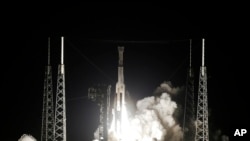Boeing's new Starliner capsule went off course after launch Friday and won't dock with the International Space Station during its first test flight.
It was supposed to be a crucial dress rehearsal for next year's inaugural launch with astronauts.
The blastoff from Cape Canaveral, Florida, went flawlessly as the Atlas V rocket lifted off with the Starliner capsule. But a half-hour into the flight, Boeing reported that the capsule didn't get into the right orbit to reach the space station. The capsule is still in space and will be brought back to Earth, landing in New Mexico as early as Sunday.
Boeing is one of two companies hired by NASA to launch astronauts from the U.S. The space agency has been relying on Russian rockets to travel to the space station since the retirement of the space shuttle almost nine years ago.
Officials stressed that the capsule was in a safe and stable orbit. NASA Administrator Jim Bridenstine said in a tweet that the capsule burned up more fuel than planned and controllers were using the capsule's thrusters to raise its orbit.
With less fuel on board, it put the rest of the flight in jeopardy. The Starliner was supposed to reach the space station on Saturday and stay for a week.
Thousands of spectators jammed the area, eager to witness Starliner's premiere flight. The United Launch Alliance rocket blasted off from Cape Canaveral Air Force Station and was visible for at least five minutes, its white contrail a brilliant contrast against the dark sky. The mood quickly turned somber as news of the setback trickled out. NASA officials deferred to Boeing for updates.
"Safe and stable is the important thing right now," Boeing spokeswoman Kelly Kaplan told reporters.
This was Boeing's chance to catch up with SpaceX, NASA's other commercial crew provider that successfully completed a similar demonstration last March. SpaceX has one last hurdle — a launch abort test — before carrying two NASA astronauts in its Dragon capsule, possibly by spring.
A successful Starliner demo could have seen Boeing launching astronauts by summer. But that might not be possible now.
The U.S. needs companies competing like this, NASA Administrator Jim Bridenstine said Thursday, to drive down launch costs, boost innovation and open space up to more people. He stressed the need for more than one company in case of problems that kept one grounded.
The space agency handed over station deliveries to private businesses, first cargo and then crews, in order to focus on getting astronauts back to the moon and on to Mars.
Commercial cargo ships took flight in 2012, starting with SpaceX. Crew capsules were more complicated to design and build, and parachute and other technical problems pushed the first launches from 2017 to now next year. Last April, a SpaceX crew capsule exploded during a ground test.
It's been nearly nine years since NASA astronauts have launched from the U.S. The last time was July 8, 2011, when Atlantis — now on display at Kennedy Space Center — made the final space shuttle flight.
Since then, NASA astronauts have traveled to and from the space station via Kazakhstan, courtesy of the Russian Space Agency. The Soyuz rides have cost NASA up to $86 million apiece.
Chris Ferguson commanded that last shuttle mission. Now a test pilot astronaut for Boeing and one of the Starliner's key developers, he's assigned to the first Starliner crew with NASA's Mike Fincke and Nicole Mann. All three were at control centers to watch the launch.
Built to accommodate seven, the white capsule with black and blue trim will typically carry four or five people. It's 16.5 feet (5 meters) tall with its attached service module and 15 feet (4.5 meters) in diameter.
For the test flight, the Starliner carried Christmas treats and presents for the six space station residents, hundreds of tree seeds similar to those that flew to the moon on Apollo 14, the original air travel ID card belonging to Boeing's founder and a mannequin named Rosie in the commander's seat.
The test dummy — named after the bicep-flexing riveter of World War II — wore a red polka dot hair bandanna just like the original Rosie and Boeing's custom royal blue spacesuit.
The flight was designed to test all systems, from the vibrations and stresses of liftoff to the Dec. 28 touchdown at the Army's White Sands Missile Range in New Mexico, with parachutes and air bags to soften the landing. Even the test dummy is packed with sensors.
On the eve of the flight, Bridenstine said he's "very comfortable" with Boeing, despite the prolonged grounding of the company's 737 Max jets. The spacecraft and aircraft sides of the company are different, he noted. Boeing has long been involved in NASA's human spacecraft program, from Project Mercury to the shuttle and station programs.
Boeing began preliminary work on the Starliner in 2010, a year before Atlantis soared for the last time.
In 2014, Boeing and SpaceX made the final cut. Boeing got more than $4 billion to develop and fly the Starliner, while SpaceX got $2.6 billion for a crew-version of its Dragon cargo ship.
NASA wants to make sure every reasonable precaution is taken with the capsules, designed to be safer than NASA's old shuttles.
"We're talking about human spaceflight," Bridenstine cautioned. "It's not for the faint of heart. It never has been, and it's never going to be."







